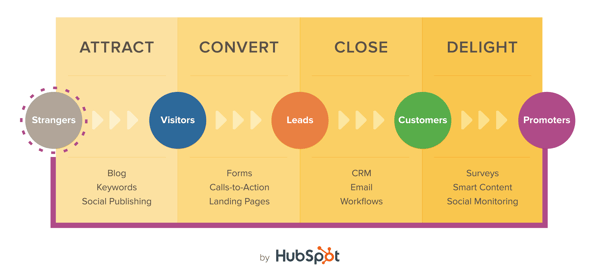What is ZMOT and Why Does it Matter to Your Business [Video]?
 What is ZMOT?
What is ZMOT?
What is the last fairly expensive purchase you made? Maybe an appliance, a car, a vacation, a class or a new bike to enjoy the spring weather? Whatever it was, how did you decide what exactly you wanted? And how did you decide who exactly you wanted to buy it from? If you're like 62% of the rest of the population, you most likely looked online and did some research? Did you read any reviews? Watch any videos about the product/service?
This process is what we call the Buyer’s Journey. And in 2011, Google coined the term Zero Moment of Truth (ZMOT) to describe the online research consumers do before they purchase a product or service. This online research now accounts for 70% of the buyer's journey. Yep, that's right - 70% of the buying process happens before a buyer ever even speaks with a salesperson (some say it's actually more like 94%). And it doesn’t matter whether it’s a B2B or a B2C sale, everyone does research online before purchasing.
Buyers Hold the Power
With the internet, buyers have access to all the information they want, when they want it.
Then What Can Marketing & Sales Do To Reach Buyers?
Basically, marketing and sales need to learn how to connect with buyers in the first 70% of their buying journey, before they contact us, and when they're doing their research. But in order to do that, we really need to understand who are buyers are and what kind of information they need. Then we need to make this information available in a place where we know they will find it.
ZMOT isn't a theory, it's a fact. So if we want to help buyers through their process before they've contacted us, gaining their trust and establishing ourselves as thought leaders along the way, there are a few things we need to do.
1. Develop Buyer Personas
Whether we call these people our prospects, target market or buyer personas, doesn't matter. What does matter is that we understand these people. Deeply.
These posts will help you if you haven't yet created buyer personas.
- How to Create a Buyer Persona
- The High Cost of Not Knowing Your Customer
- How to Build Data-driven Personas Using Facebook Insights
If you do have buyer personas, but you're not sure you have enough detail, you could also do customer interviews to gain more insight.
2. Personalize Our Marketing Content
Have you ever received an email you thought was just for you, only to find it was a generic email blast and not relevant to you or your life? What do you do with these emails? Do you delete them? So do I. If the sender doesn't personalize the message somehow, and I'm not just talking about including your name at the top, it's difficult for the receiver to understand the relevance and the message gets filed in the trash. Probably before being read.
However, when we've done the work to develop Buyer Personas, and we really understand our prospects, their challenges, what gets them excited, what they need help with, etc., we can personalize our content for each persona and for the stage they are in on their journey.
As a brief recap on Inbound Marketing Methodology, there are four stages :
 We want to make sure that the content we create is relevant for our buyer persona AND for where they are in their buyer's journey. Here is more detail on how to map content to the buyer's journey.
We want to make sure that the content we create is relevant for our buyer persona AND for where they are in their buyer's journey. Here is more detail on how to map content to the buyer's journey.
3. Personalize Our Sales Process
From inbound marketing, we know the best leads are inbound ones because these people have told us they're interested in learning more about our product or service, or us. But if you're a salesperson with a quota, and you don't have enough inbound leads to follow up on, what do you do?
Without inbound leads, we need to resort to traditional outbound methods; cold calling, emailing, tradeshows, networking and the like. But if we know prospects don't like to be cold called or spammed (because we don't either!), how can we do these things in a more inbound-y way so that we get the opportunity to actually connect with our prospect?
The answer is Inbound Sales. We need to reach out in ways that educate or help our prospect in their challenge so they understand it better, and realize we understand it too. Secondly, we need to personalize our outreach so that it's relevant to that person. The days of copying and pasting the same exact message to 50 leads are over. We want to know if our prospect has a problem that we might be able to help solve, and whether they want our help.
CONCLUSION:
So to answer our original question, ZMOT matters to our business because most of the buying process happens before the prospect connects with us. Empowered buyers with access to information is a good thing for all of us as consumers, but it requires a new strategy from marketing and salespeople to be successful. We need to know how to transition our roles into one of an educator, teacher, and trusted advisor in order for our prospects to want to connect with us. We can accomplish this by creating valuable and personalized content.
Share this
You May Also Like
These Related Stories

How Can I Get More Home Buyers to Visit My Website?

How to Generate a Year’s Worth of Blog Topics in One Meeting


/Accreditations/CRM-Implementation-Accredited-Badges.png?width=170&height=138&name=CRM-Implementation-Accredited-Badges.png)
/Accreditations/Onboarding-Accredited-Badges.png?width=170&height=137&name=Onboarding-Accredited-Badges.png)
/Accreditations/Custom-Integration-Accredited-Badges.png?width=170&height=137&name=Custom-Integration-Accredited-Badges.png)

